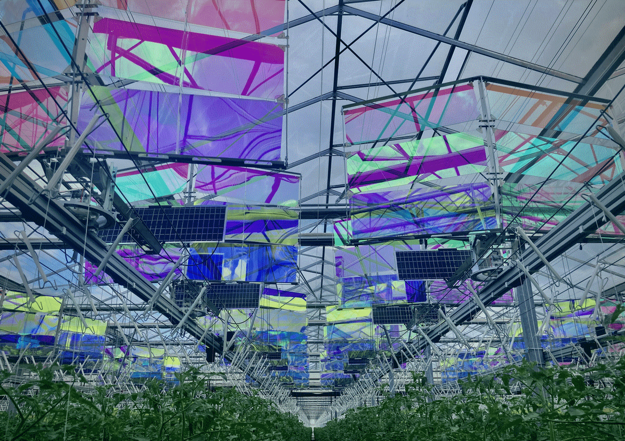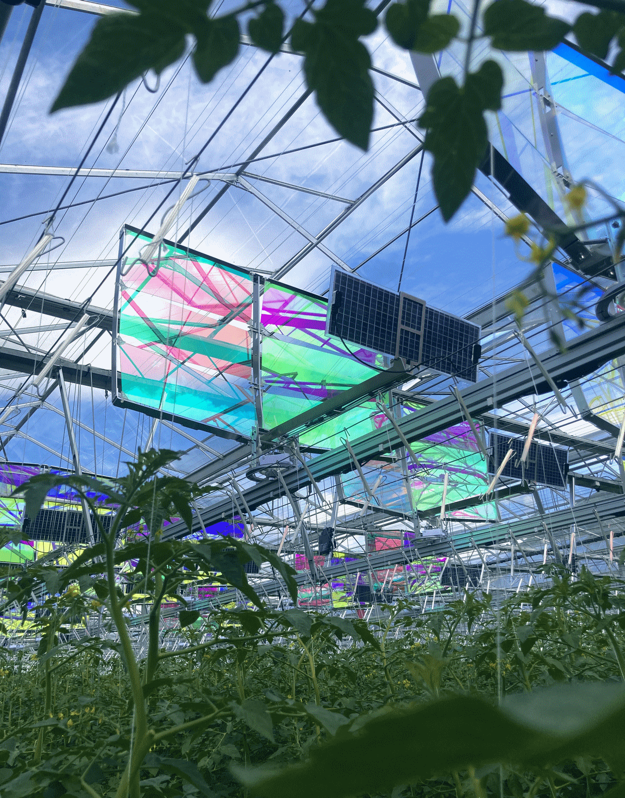In the realm of very cool greenhouses, here's a Swiss facility we would like to show you. At this location, Voltiris harnesses energy using spectral filters and solar panels suspended above the crops. The approach involves splitting the incoming sunlight through spectral filters. All the frequencies that are essential for the crop pass through; the rest is used for sustainable energy production.
The approach involves selectively allowing the essential frequencies of light to reach the plants while reflecting the remaining frequencies toward solar panels for energy production. According to Kaz Vermeer of Voltiris, this innovative method seamlessly integrates sustainable energy production with crop cultivation without the loss of light for the crop.

Selectively allowed frequencies
Plants utilize only certain frequencies of the available light spectrum. With this knowledge in mind, Voltiris has developed specialized filters that permit this critical spectrum to penetrate while the remaining light is cleverly concentrated by six filters onto small solar panels. "The most important energy contribution comes from infrared radiation usually associated with heat. We remove the thermal radiation by turning it into green energy," explains Kaz, who is part of the Voltiris team from the Netherlands. The company was founded by school friends Nicolas Weber, Dominik Blaser, and Jonas Roch in Switzerland.
 Electrification
Electrification
Voltiris has identified significant potential for their technology, particularly in the cultivation of greenhouse vegetables. "We see an international drive towards sustainable growth. As a result, electrification is gaining prominence across the industry. Relying solely on the grid is also becoming less desirable due to price volatility," Kaz elaborates. The technology also offers potential benefits in other agricultural sectors. For instance, in the propagation phase, filtering out far-red light can serve as an alternative to growth inhibitors, resulting in more compact plants. Furthermore, Voltiris envisions applications in ornamental horticulture, as previously demonstrated in a trial at Royal van Zanten in Rijsenhout. "Numerous cut flowers require abundant sunlight but don't benefit from the associated heat. In such cases, our technology provides an effective solution."
In addition to their Swiss facilities, Voltiris has been conducting trials with tomatoes at Wageningen University and Research. The current season yielded an impressive output, aligning closely with conventional cultivation standards. The company is also exploring the agronomic benefits of filtering infrared light. "By removing part of the thermal radiation, we have the potential to reduce greenhouse temperatures without the need for increased ventilation, allowing growers to keep their windows closed and maximize CO2 concentrations," Kaz notes.
Following the sun
One distinctive feature of Voltiris' approach is its deliberate decision not to integrate solar panels into the greenhouse roof. "The efficiency of our unique filter is highly dependent on the angle at which light enters. Fixed angles would result in variable refractions and, consequently, inconsistent light frequencies. By ensuring that the filters and panels follow the sun's movement, we maintain a constant refraction," Kaz explains. Furthermore, the vertical positioning of filters and panels minimizes any obstruction to airflow in the greenhouse. "While greenhouse conditions may be warm and humid, solar panels are far more tolerant compared to outdoor environments. Our system is adaptable to all modern greenhouses, with the modules situated up high, minimizing disruption."
Currently, Voltiris' largest installation is located at Switerzland's largest cherry tomato producer, Les Serres des Marais. Looking ahead, Voltiris plans to scale up in Europe next year. With around 3000 modules, approximately ten thousand square meters of greenhouse space will be optimized for crop cultivation and electricity generation. Beyond this, they are preparing a test at Delphy Improvement Center, installing their technology above the shade screen in bell pepper cultivation. "The shading screen actually works as a reflector, shining even more light on our modules," Kaz states. "We anticipate that by eliminating radiant heat, we can reduce the need for shading screens and ventilation and potentially allow for cultivation with higher light and CO2 levels."
Voltiris is actively seeking partner growers to launch pilot projects. They are particularly interested in growers with active cooling needs and a commitment to sustainable energy practices. "We've demonstrated our ability to successfully grow crops while generating electricity in trials. Now, we're eager to scale up our solutions in practice, together with innovative growers."
For more information:
Voltiris
[email protected]
www.voltiris.com
